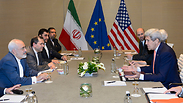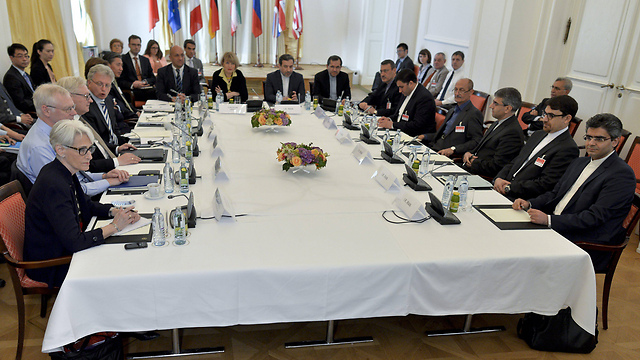
Fresh push in Iran nuclear talks in Tehran, Vienna
IAEA chief in Tehran to hold talks on stalled probe into Iran's suspected nuclear bomb development, while foreign ministers of France, German, UK and China expected to join US and Iranian counterparts in Vienna talks.
Major-power foreign ministers and the UN atomic watchdog chief were set to launch a fresh two-pronged push Thursday to nail down an elusive nuclear deal with Iran in a sixth day of high-stakes diplomatic poker.
International Atomic Energy Agency chief Yukiya Amano was expected to hold talks in Tehran, seeking a way around one of the thorniest issues in the long-running talks: a stalled probe into Iran's suspected nuclear bomb development.
The foreign ministers of France, Germany, Britain and China were expected to join the main talks in Vienna, where US Secretary of State John Kerry and Iran's Mohammad Javad Zarif have been locking horns since Saturday.
EU foreign policy chief Federica Mogherini will also take part. It was unclear if Russian Foreign Minister Sergei Lavrov will also return to the Austrian capital.
"We are working very, very hard and we have some very difficult issues," Kerry said Wednesday, a day after the deadline for a deal was effectively extended to July 7.
"But we believe we're making progress and we're going to continue to work because of that," he told reporters.
Amano's visit to Tehran at Iran's invitation, where he will meet President Hassan Rouhani and other officials, is aimed at jump-starting a stalled probe into allegations of past suspicious nuclear activity by Iran.
The P5+1 powers - the United States, Russia, China, Britain, France and Germany - want Iran to cooperate in the investigation, saying it is a vital piece of the mooted accord.
But Iran rejects the allegations that its nuclear program had "possible military dimensions" saying they were based on bogus intelligence provided by the CIA and Israel's Mossad.
It also baulks at the desire of the IAEA - which it sees as biased and riddled with spies - to visit military sites such as Parchin and interview its scientists.
Breaking the deadlock
One possible compromise might be strictly controlled "managed access" visits that reassure Iran that IAEA staff are not spying on its military facilities under the guise of inspections, experts say.
"It is critical that the agency has the access and information it needs to complete its investigation while respecting Iran's legitimate security concerns," said Kelsey Davenport, director for non-proliferation policy at the US-based Arms Control Association.
Amano's visit would "hopefully" pave the way to the resolution of a "sticking point" in the talks, Davenport told AFP.
Iranian agency ISNA said the country's leaders would offer "suggested solutions" to the deadlock.
The hoped-for accord, after almost two years of negotiations and 13 years of rising tensions, focuses more on the future rather than the past, however.
Under a framework deal from April, Iran will scale back its nuclear activities with the aim of putting the development of an atomic bomb beyond its reach and in return, painful sanctions would be progressively lifted.
Iran denies seeking the bomb, saying its activities are for peaceful purposes like generating electricity.
An accord would be a rare diplomatic success in the Middle East, potentially putting Iran on the road to better international relations - a prospect that alarms rivals Israel and Saudi Arabia.
But finalizing the framework agreement from Lausanne, Switzerland has proved difficult, and on Tuesday negotiators effectively extended their deadline to get a deal until July 7.
Tough issues include the pace and timing of sanctions relief, the mechanism for their "snapback" and Iran's future development of faster nuclear equipment.
Meanwhile, the IAEA said in its monthly report on Iran, a confidential document seen by Reuters on Wednesday, that Iran's stockpile of uranium gas enriched up to a fissile purity of 5 percent was at 7,537 kg at end-June - below a roughly 7,650 kg ceiling stipulated in the November 2013 interim nuclear deal with six world powers.
A US-based think-tank, however, issued an analysis of the IAEA report that questioned whether Iran had indeed complied with the requirement to convert its low enriched uranium (LEU) to a form with less risk of proliferation, uranium dioxide.
"The IAEA's recent report on the implementation of (the interim deal) shows that only 9 percent of Iran's stockpile of newly produced LEU hexafluoride has actually been converted into uranium dioxide form," the Institute for Science and International Security said in a press release.
"When it became clear that Iran could not meet its commitment to convert the LEU into uranium dioxide, the United States revised its criteria for Iran meeting its obligations," the institute said, adding that the LEU had apparently been converted into a form different from uranium dioxide.
"Iran had two requirements under the (interim deal): to end the time period with the same amount of UF6 they began it with, and to convert any excess UF6 produced into an oxide form. They've done both," a senior US official told Reuters.
The IAEA did not have an immediate response to a query about its report.
Reuters contributed to this report.











